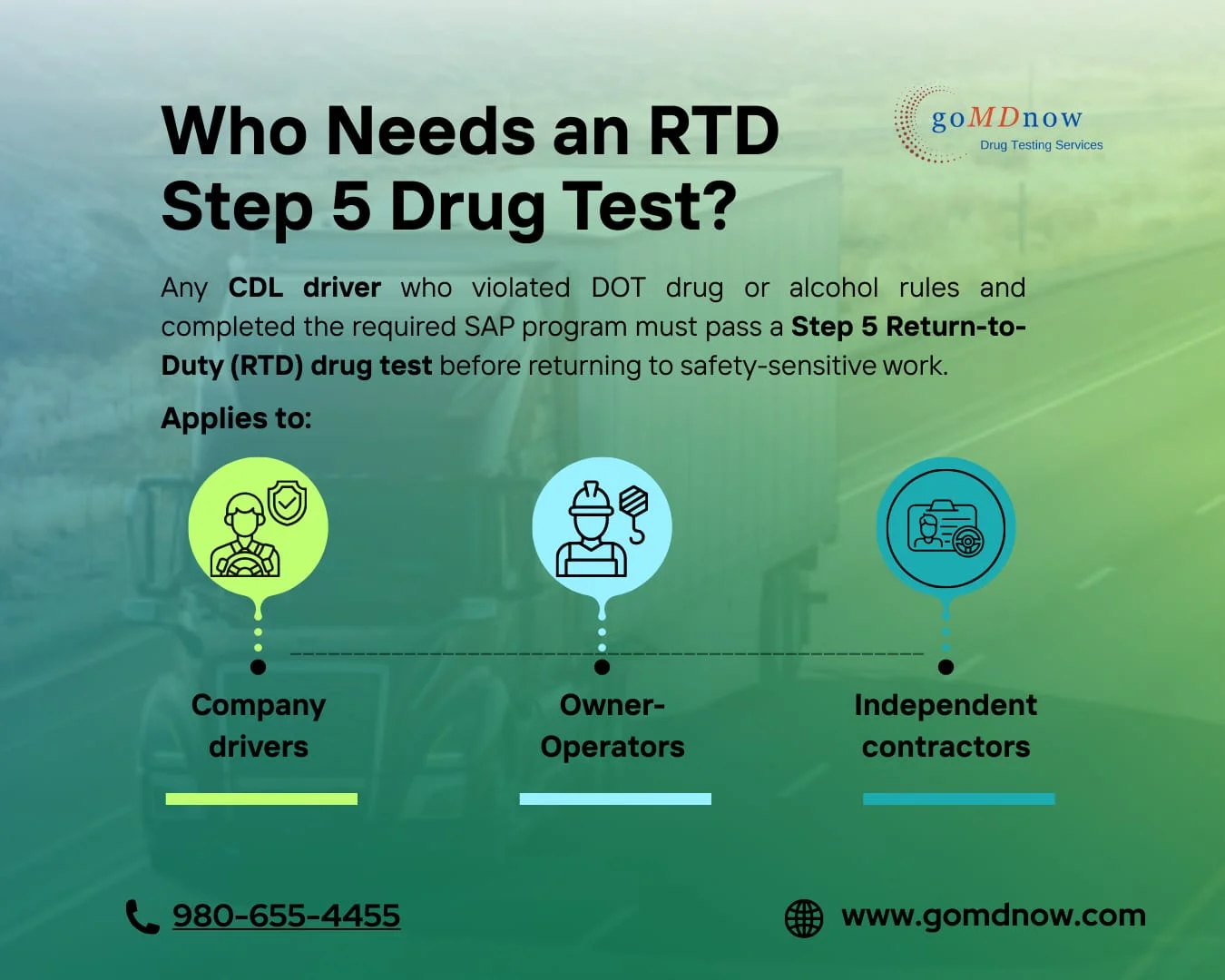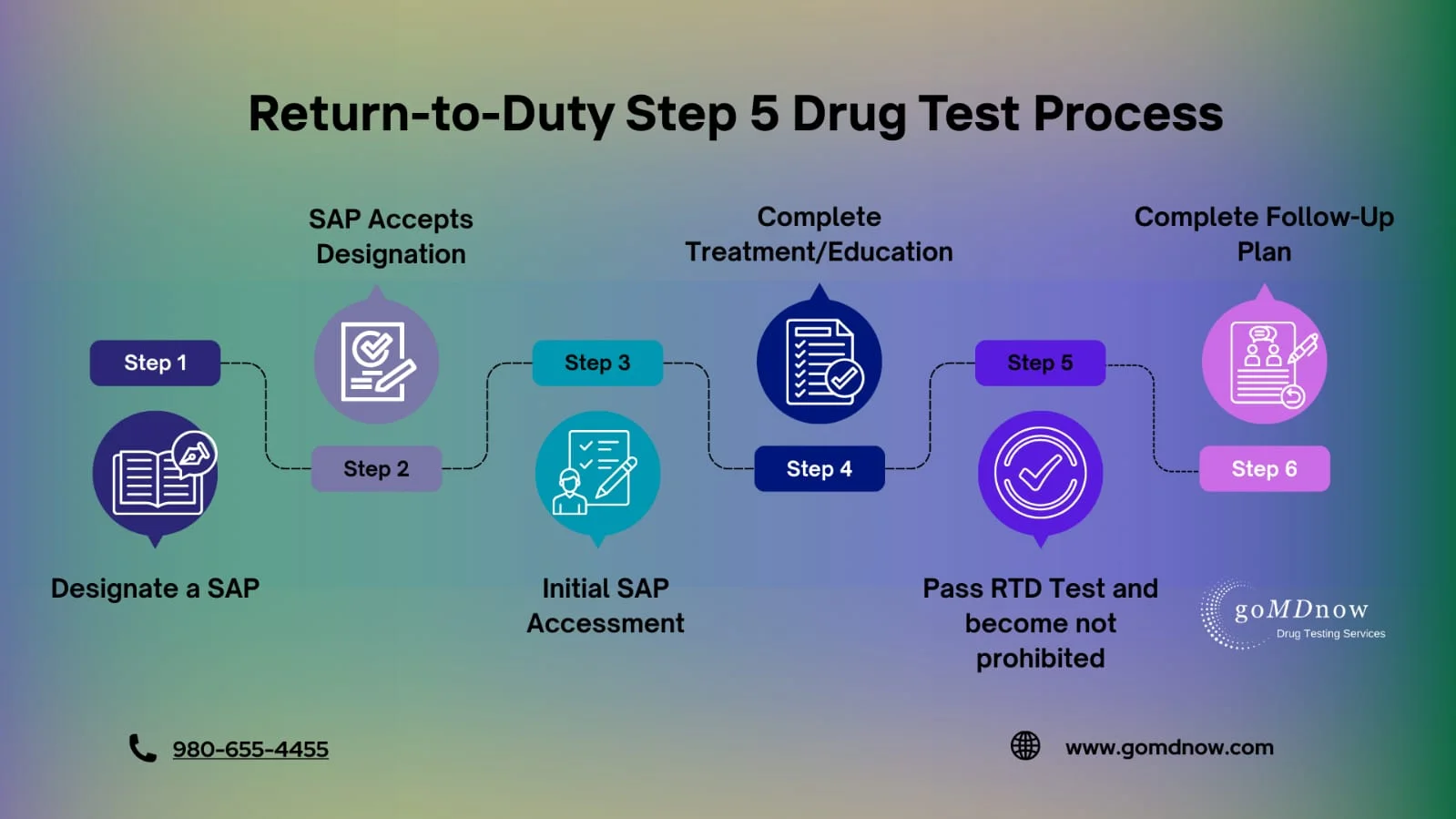

The Return-to-Duty (RTD Step 5) drug test is a federally required DOT drug test that must be completed after a driver violates DOT drug or alcohol regulations and before returning to safety-sensitive duties.
This requirement is mandated under 49 CFR Part 40 and is overseen by the FMCSA Drug & Alcohol Clearinghouse. A driver cannot legally operate a commercial motor vehicle until a verified negative RTD test result is completed and properly reported.
*Include Observed Urine Drug Test For $114.95*
*FMCSA Clearinghouse Reporting $35.00*
*Include Follow-Up Plan Setup For $99.95*
*FMCSA Clearinghouse Reporting $35.00*
Note: (Step 1 to 4) SAP Assessment are not included in this price. goMDnow is not responsible for any SAP Assessments.
A Step 5 Return-to-Duty drug test is required for any CDL driver who has committed a DOT drug or alcohol violation and completed the evaluation and education or treatment required by a DOT-qualified Substance Abuse Professional (SAP).
This requirement applies to:

RTD Step 5 and Follow-Up Testing serve different compliance purposes and must not be confused.
| Step | Purpose |
|---|---|
| Step 5 | One-time Return-to-Duty drug test required to regain eligibility |
| Step 6 | Ongoing SAP-directed follow-up testing program |
This page focuses exclusively on RTD Step 5. Follow-Up Testing details are covered separately on our DOT Follow-Up Testing (Step 6) page.
Note: goMDnow does not perform SAP evaluations (Step 1 to 4). SAP services are provided independently by certified professionals, as required by DOT regulations. goMDnow is not responsible for any SAP Assessments. SAP Assessment must be completed by independent SAP before submitting Return to duty drug test. In order to report your RTD information into FMCSA Clearinghouse, user must select "goMDnow LLC" as designated C/TPA from their Employer, Owner Operator or student driver's account.
Before a Return-to-Duty test can be scheduled, the driver must be evaluated by a DOT-qualified SAP, complete all required education or treatment, and receive written authorization to proceed. Without SAP clearance, a Return-to-Duty test cannot legally be performed.
The Return-to-Duty drug test must be conducted under direct observation by a same-gender trained collector at a DOT-certified collection site. Direct observation is mandatory for RTD testing and cannot be waived under any circumstances.
The specimen is sent to an HHS-certified laboratory and reviewed by a licensed Medical Review Officer (MRO). Only a verified negative result satisfies the DOT Return-to-Duty testing requirement.
Once the test is verified negative, the result is reported to the FMCSA Drug & Alcohol Clearinghouse. The driver’s status changes from “Prohibited” to “Not Prohibited”, allowing the driver to legally return to safety-sensitive duties.
goMDnow assists both drivers and employers by coordinating DOT-compliant RTD Step 5 testing nationwide. Our services include scheduling directly observed collections, providing access to over 20,000+ DOT-certified collection sites, and ensuring accurate Clearinghouse reporting.

RTD Step 5 pricing typically includes the DOT-observed urine drug test, certified laboratory processing, MRO verification, and Clearinghouse reporting support. Pricing may vary based on location and service availability.
For exact pricing and scheduling, contact goMDnow directly.
After successfully completing Step 5, the driver enters the Follow-Up Testing (RTD Step 6) phase. Follow-up tests are unannounced and conducted over a period determined by the SAP.
If a driver fails the RTD drug test, they remain prohibited from performing safety-sensitive duties and must restart the SAP process. Multiple violations may result in long-term or permanent disqualification.
All DOT drug and alcohol violations remain recorded in the FMCSA Drug & Alcohol Clearinghouse for five years, and employers are required to review Clearinghouse records before hiring CDL drivers.
No. Step 5 is a one-time return-to-duty test required after a violation. Random testing resumes only after Step 6 begins.
Yes. Owner-operators may complete RTD Step 5 using a qualified C/TPA, provided Clearinghouse requirements are followed correctly.
The driver remains prohibited and must:
In many cases, yes — depending on SAP clearance and collection site availability.
It may, depending on the original violation and SAP instructions.
Yes. RTD test results are recorded in the FMCSA Clearinghouse and visible to authorized employers.
RTD completion remains in the Clearinghouse as part of the driver's compliance history.
After passing Step 5:
If you fail the RTD drug test, you cannot return to safety-sensitive duties. You may need to repeat the SAP program, and your employer may take further action. Multiple violations can result in permanent disqualification from operating CMVs.
Yes. All DOT drug and alcohol violations are recorded in the FMCSA Drug and Alcohol Clearinghouse for five years. Employers must check a driver's Clearinghouse record before hiring them for a safety-sensitive position.
If you are ready to complete your DOT Return-to-Duty test and Step 5 follow-up testing requirements, goMDnow can help you stay compliant and get back on the road legally.